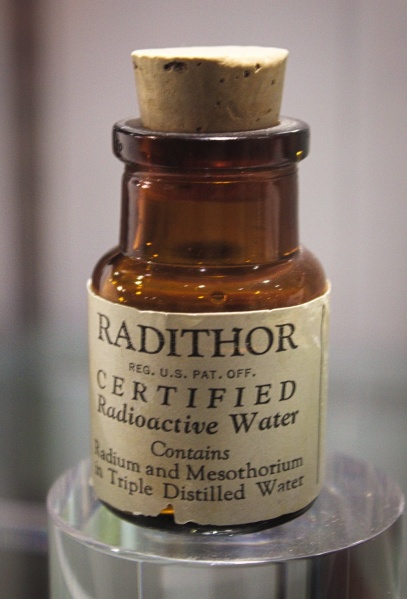File:Radithor.jpg
Modern life have you feeling frazzled? Flagging a bit as you rush through your day? Maybe you’re one of the millions of consumers who lean on energy drinks to put a little extra pep in your step.
Though emblematic of our time, energy drinks aren’t an invention of the new millennium. People have relied on them to combat fatigue for at least a century. Today, their “energy” typically derives from some type of neurological stimulant that makes people feel more energetic, or sometimes just sugar.
But there was a time when energy drinks actually contained real energy. The active ingredient in these drinks was radium, a radioactive element that releases a packet of radiant energy with every atomic decay. While the connection between consuming a radioactive element and reaping a perceived energy boost is tenuous at best, it didn’t stop people in the early 1900s from ignoring the known downsides of ingesting radioactivity and risking the long-term health consequences. Yum yum radium? RadiThor claimed to be a panacea for a variety of health ailments. Sam L., CC BY-SA
One of these energy-containing products was RadiThor. This energy drink was simply radium dissolved in water. It was sold in the 1920s in one-ounce bottles costing about US$1 each ($15 in 2016 dollars). Its manufacturer claimed the drink not only provided energy but also cured a host of ailments, including impotence. Evidence for a sexual benefit to humans was lacking, but at least one scientific paper claimed that radium water could increase “the sexual passion of water newts.” For many men, in this pre-Viagra era, the water newt evidence was enough. RadiThor was a big seller.
RadiThor’s most famous customer was Eben Byers, a Pittsburgh industrialist and amateur golfer of some repute. Byers first became acquainted with RadiThor when he took it to help heal a broken arm. Although the product contained no narcotics at all, Byers became at least psychologically, if not physiologically, addicted to it. He continued to consume large amounts of RadiThor even after his arm had healed. He reportedly downed a bottle or two daily for over three years, and sang its praises to all his friends, some of whom also took up the RadiThor habit.
In the end, Byers’ RadiThor addiction killed him. Unfortunately, ingested radium gets incorporated into bone and all of its radiation energy is, therefore, deposited in bone tissue. Over time, the radium delivered a whopping radiation dose to Byers’ skeleton. He developed holes in his skull, lost most of his jaw and suffered a variety of other bone-related illnesses. Ultimately, he died a gruesome death on March 31, 1932.
source: https://theconversation.com/when-energy-drinks-actually-contained-radioactive-energy-67976
File history
Click on a date/time to view the file as it appeared at that time.
| Date/Time | Thumbnail | Dimensions | User | Comment | |
|---|---|---|---|---|---|
| current | 15:38, 20 April 2019 |  | 1,000 × 1,471 (162 KB) | Pile (Talk | contribs) | (Modern life have you feeling frazzled? Flagging a bit as you rush through your day? Maybe you’re one of the millions of consumers who lean on energy drinks to put a little extra pep in your step. Though emblematic of our time, energy drinks aren’t an) |
- Edit this file using an external application (See the setup instructions for more information)
File usage
The following page links to this file:
This site costs a lot of money in bandwidth and resources. We are glad to bring it to you free, but would you consider helping support our site by making a donation? Any amount would go a long way towards helping us continue to provide this useful service to the community.
Click on the Paypal button below to donate. Your support is most appreciated! |
|---|



